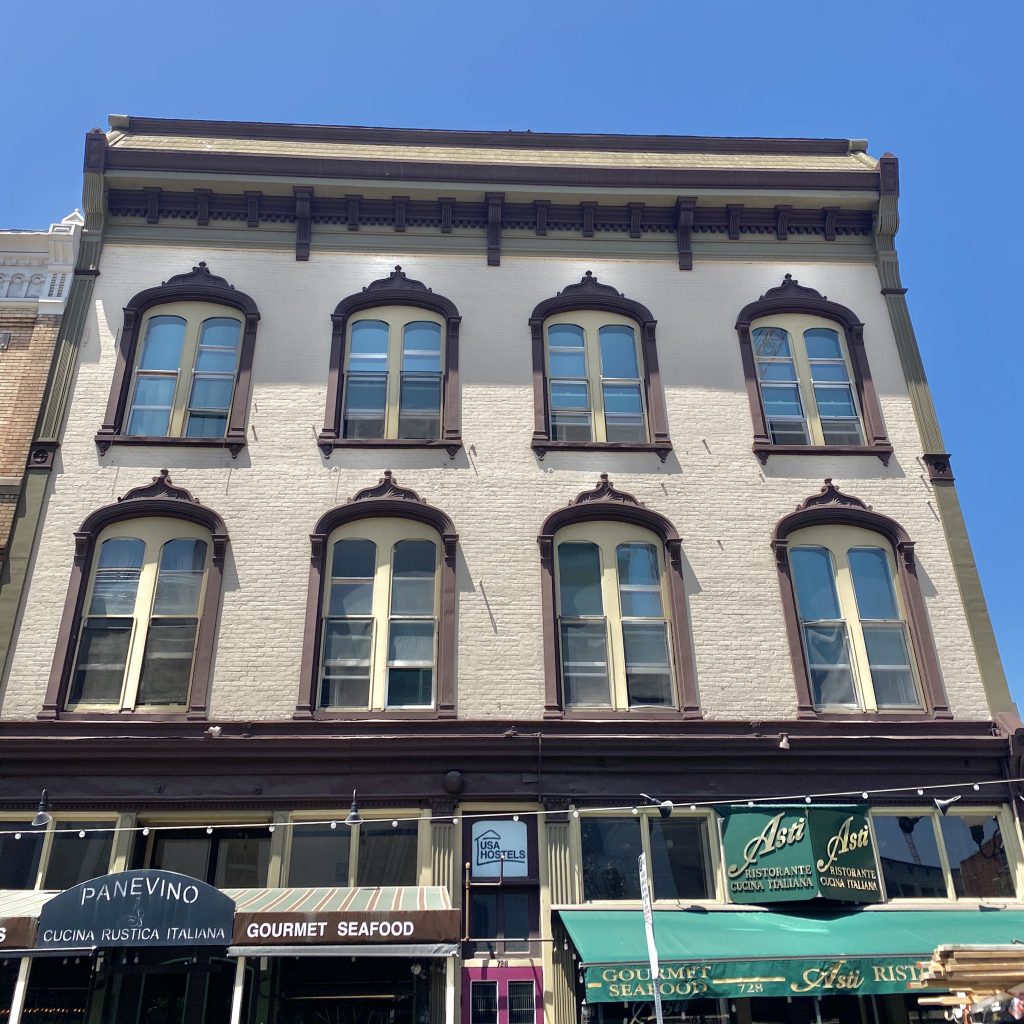No products in the cart.
Landmarks
Not Exactly the Favorite Son!
Llewelyn Building
1887
722 – 728 5th Avenue
Architectural Style – Victorian/French Provincial
Architect – Unknown
David Llewelyn, a Welsh immigrant, arrived in San Diego in 1869, and like many others, immediately set out to make his fortune. Quite successful, he built and operated a number of stores, including several cigar emporiums. When he died in 1896, he left his son William only $10.00, and left the remainder of his estate to his daughter, Hannah Elizabeth Allen, making her a “woman of means.”
Perhaps sensing his father’s favoritism, William had already partnered up with E.M. Rankin, and the pair operated a brick kiln, which supplied thousands of bricks for local construction in the 1870s and 1880s. In 1884, William acquired the property on 5th Avenue from James Findla. He began construction of the Llewelyn building in late 1887.
Although the architect is unknown, the architecture is unique in the Gaslamp, as it is the only building sporting French Provincial characteristics. Those include a a Mansard roof and highly arched windows with ornately carved moldings and elaborate cornices. Mansard roofs have slopes on four sides and sit on a flat foundation. The arches and cornices were constructed of pressed metal and the windows, four on each side of the building, were double sashed.
The three story building itself was constructed of brick bearing walls on a concrete foundation with no basement. There is, however, a crawl space beneath the first floor. The elaborate roofline features intricately carved lentils, and includes a large light-well (skylight) opening to the second floor to provide illumination and ventilation. On the ground floor, a large central doorway led to a central staircase. The door and interior window trim were molded redwood. The interior doors were hinged, although some of the larger rooms also had pocket doors. Ceilings on the second and third floors are 14 feet high. The building originally incorporated gas lighting.
When the structure opened, William Llewelyn installed a shoe store, which he operated until 1906. The building, which was constructed for “general merchandising,” included as early tenants the San Diego Trucking Company, two architects – Mr. Pare and Mr. Kennedy – Bachman and Hooker – cement construction and a cigar store. In 1906, Anker Western Wear founded their company in the building, and remained until May 1, 1973.
In 1906, the upstairs levels were converted to a series of hotels. The first hotel was the the Dunlop. In 1915, Mr. Llewelyn sold the southern half of the building to Mrs. Emma R. Southerland.
Unfortunately, each hotel that followed the Dunlop became more and more unsavory, and by 1917, the current hotel, the Louis Hotel, was known as a “cat house.” When charges were brought against Mrs. Southerland as the owner, she said she did not own a “cat house,” promptly tried to have the charges dropped, and the tenant manager, Mrs. Ollie Thomas, was told to leave. George M. Sears, the police officer who originally filed the suit testified that the Louis Hotel had a general reputation as a “house of ill-fame and a house where prostitution was allowed and encouraged.” He went on to state that Mrs. Holmes also had a bad reputation and allowed tenants such as Myrtle Allen and Josephine Alvarado, who had been arrested for prostitution twice before, to continue to live there. After much more testimony, Judge C. N. Anderson ordered the two owners, Llewelyn and Southerland, “ to absolutely desist and refrain from using the said premises for purpose of lewdness or prostitution, and from permitting such a nuisance on said premises.” In 1919, Mrs. Southerland sold her interest in the property. Mr. Llewelyn died in 1921, and left the property to his wife, Mrs. Emily Llewelyn.
Sadly, the Louis was followed by the Coronado Hotel , the Welcome Hotel and the Utah Hotel, and the illicit activities continued. The downstairs storefronts became the Aztec Bar (closed due to abatement of nuisance), a pawnbroker, a loan office, the Telephone Bar and Wimpey’s Cafe. When Anker Western Wear moved out in 1973, that space became the Lux Adult Theater. An unfortunate downward slide for such a lovely building! Still lovely, but now very notorious.
In the latter 1970s, the late Zondra Schmidt, a Gaslamp pioneer, purchased the building and operated the hotel, now called the Neptune, as a low-income residential facility. She later recounted her surprise when opening what she thought to be a storage area and finding many, many lockers. Apparently, the property had also been a “locker club,” where servicemen could keep and change into civilian clothes when they came to enjoy the various types of entertainment that the then Stingaree had to offer!
The Llewelyn went through an extensive restoration in 1981, and then opened its doors to a hostel catering to international travelers upstairs, and a restaurant on the street level. In 1992, Osteria Panevino opened its doors at the location, and bills itself as the oldest restaurant in the new Gaslamp. Adjoining it on part of the original property is another popular restaurant, Asti. USA Hostels continues to operate upstairs. These elegant restaurants and lively hostel do much to mitigate the notorious reputation of this grand old building!
Sandee is the historian at the Gaslamp Quarter Historical Foundation. She can be reached at [email protected]

